S2: E37 Roofing Road Trips with Heidi with Matthew Lennox- PODCAST TRANSCIPTION
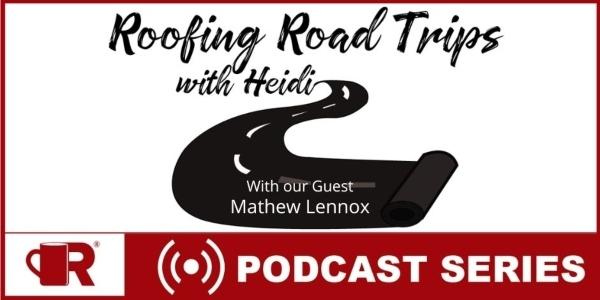
Editor's note: The following is the transcript of an interview with Matthew Lennox, CEO of Stormseal. You can read the interview below or listen to the podcast here.
Heidi Ellsworth: Hello, and welcome to another Roofing Road Trips with Heidi. This is Heidi Ellsworth, partner at RoofersCoffeeShop. And today, it is my privilege to have Matthew Lennox, CEO of Stormseal with us on this podcast. Welcome, Matthew.
Mathew Lennox: Hello Heidi, and hello RoofersCoffeeShop.
Heidi Ellsworth: We've got all kinds of people listening to you, all the way from Australia to the US. You've got the whole global thing going today, Matthew.
Mathew Lennox: I know, I know. I love it. I'm so privileged to have the opportunity to talk to you, Heidi. Yeah, I'm looking forward to it.
Heidi Ellsworth: Well, you know what? I have just been ... For everyone out there, Tim Ellsworth, my husband and I, we have spent some great time with Matthew at the different trade shows, and just talking about his business, and really being able to be a part of this awesome technology that you've brought to the US. You know what? Very first thing, Matthew. Why don't you explain what Stormseal is, so that everyone knows, for anyone who may not have heard about it.
Mathew Lennox: Yeah, sure. Stormseal is a polymer film which heat shrinks to a damaged structure, and unlike tarpaulins, will stay on until such time the permanent repair process can be undertaken. Basically, it's like a tarpaulin but it's shrink wrapped to your roof, and it will protect those occupants until such time they have their insurance processed, or they can afford to actually do their roof.
Heidi Ellsworth: You know what? I just don't know what we would do without all those blue tarps. I know Tim, at one point, had some blue tarps up at my parent's house. And he threw tires on top of it, too, just to tease my mom. I'm thinking Stormseal looks a lot better to protect that roof as it's going through after those kind of incidents.
Mathew Lennox: I remember that conversation with Tim, actually. I think a couple of the tires ended up getting blown off as well, ended up down the road. It certainly is something to circumnavigate, that continual replacement process. I know that, obviously, a lot of the blue tarps and so forth are procured at retail outlets, but a lot of those tarps are made in China. They're a temporary, or an extremely emergency response product. You put them on when it's raining, but it's not going to last for any length of time. And certainly, when you talk about insurance, we're talking about a long process to getting a house repaired.
Heidi Ellsworth: Yeah. Right now, with Laura just going through still recovering from storms last year, and now today Sally is hitting in Alabama. We know how long it takes to get these roofs replaced, and to be able to get into a neighborhood and get it safe quickly, that's pretty incredible. Tell us a little bit about how the contractors are doing that with Stormseal.
Mathew Lennox: Okay. The way we've structured Stormseal is we have a training program, which is a two-day training program. Contractors attend that program, and providing that they're successful, they are issued a username and password. So it's really important to note that we don't sell to everybody, we only sell to, generally, licensed roofing contractors that have got applicable insurances and licenses. But also, with that username and password, they can access the product Stormseal, and tools and equipment that we sell. With that comes, I guess, in a process where first responder and insurance carriers look at that as a well trained and efficient way to actually secure homeowners, or their policy holders.
Heidi Ellsworth: Yeah, it makes sense. When you can get contractors, licensed contractors in there quickly and they can cover the roofs, everyone is saving money because we know what water damage does.
Mathew Lennox: Yeah, that's right Heidi. I mean, wherever I go in the world, whether it be Australia or even over in Europe, and certainly in America, what we have found in working with a number of reinsurers that actually reinsure the insurers, there's a lot of evidence that points to, when a storm occurs and a temporary product like a tarp is used, we have exponential blowout of the costs. An example of that is, say, Hurricane Michael in October 2018. We had a situation where it was initially reported, the $3.5 billion event. In the insurance space, they call it creep, so you get insurance creep which the claim actually creeps up a little bit, because of maybe the assessor didn't see everything, or maybe there's a little bit of extra damage that wasn't reported. But, what we're seeing after those big storms, this exponential rise in costs. Currently, Hurricane Michael, as of I think it was February of this year, was reported to be closing out at around about $8 billion. We're talking about a $5 billion increase in costs. Now, I'm not saying that everything's attributed to tarps blowing off, but a high portion, from our evidence, is a result from a tarp failure. You're looking at a tarp being, maybe, 10 cents a square foot product, over protecting sometimes $200, $300 a square foot building. When that tarp blows off and that internals get damaged, you've got this exponential rise in cost. That's something, as I said, with the reinsurers that have been very mindful of that. Obviously, something that Stormseal has been relying upon is providing that evidence to show that tarps don't work.
Heidi Ellsworth: Yeah. No, yeah. I think that's what we're seeing, across the board. Just a little side note, but right now in Australia, isn't Stormseal required after storms?
Mathew Lennox: Well, from reinsurance providers that we're working with yes, on some particular claims they do require Stormseal. We were unfortunate. I know that there's all the fires there, on the West Coast of the US at the moment. We were unfortunate enough to have all those fires as well, in Australia, at the start of 2020. Following that, immediately after those fires, we had this huge hail storm. The Capital territory, like Washington I guess, in [Canberra 00:07:50] here, got really, really belted up by hail. For that, yeah Stormseal was specified on a number of major, major projects. One of those being the National Library of Australia, so that would be like covering the National Library in Washington, for instance.
Heidi Ellsworth: Right. Wow.
Mathew Lennox: Yeah. They used that because those particular claims, it's a copper roof, beautiful roof, heritage listed building. Those type of claims take a long time. I mean, there's heritage architects involved, there's multiple government bodies involved, and insurance carriers that provide the asset protection. Inevitably, that claims going to be, minimum, six months before it gets ... Even before anyone swings a hammer, it's going to be at least six months.
Heidi Ellsworth: Yeah. With everything that's going on right now, I know we're dealing with COVID, we're dealing with the fires, we're dealing with storms coming in. We had a huge hail season here in the US. I mean, all the contractors and the suppliers are really being taxed to get everything done. I mean, there are backlogs right now so to have this kind of system that really protects the roof, and gives everybody a little bit of breathing time to be able to get the new roofs on, that's huge for a contractor's business.
Mathew Lennox: That's right, Heidi. That's what it does, it buys you time. It buys the homeowner time to maybe get two or three quotes. But, from a roofer's perspective, what we've seen is really good growth in people's businesses that have gone out, they've gone and invested in Stormseal. They've gone and done the training, they've bought a Stormseal startup kit, they've got a couple of rolls of film. They've gone out, and they've helped the homeowner. That's the number one thing, is to help that homeowner in that time of need to secure their house, that's the first thing. But, second to that is that, very often, because you've built a good rapport with that homeowner, and you've gone out and helped them in that time of need, they're very, I guess, conductive to actually getting that contractor to do the actual repair. What I mean by that is a $500, or $1000 Stormseal job might lead to a $15,000 re-roof job. And what we've seen is very good evidence, both here and in America, the US in particular, about people actually increasing their turnover for their business because they get the make safe, and then they get the job.
Heidi Ellsworth: Yeah, that makes so much sense. I'm sure you're seeing this as much as we are, but there is a line of storms in the Atlantic right now. I just can't believe they keep coming rolling off Africa.
Mathew Lennox: I know. I think, though, I was reading yesterday that it might have been the second time ever that they've got six active storms, and another one's just popped up. So we're looking at seven active storms in the Atlantic. There's one, actually, in the Bay of Mexico. But, having looked and followed the storm seasons for the last 12, 13 years, both here and in America, yeah I can safely say I've never seen anything like that.
Heidi Ellsworth: Yeah.
Mathew Lennox: You look at Dorian last year, Hurricane Dorian was the most powerful Atlantic hurricane that was ever recorded. There's no doubt about it, we seem to be getting, with the wildfires, and the huge hail events, and these increased risk, I guess, or chance if you like, of major storms like Hurricane Laura, or Sally, or Dorian. Yeah I don't know, it just seems to be certainly something that doesn't seem is going to change, if not going to get worse.
Heidi Ellsworth: Yeah. One of the things I've been thinking about, and we all think about a long time, and this is where I really ... Now, I know you do a lot of work in Florida, but really this is happening all over the country. Obviously, it's hail in the Midwest, fires in the West, hurricanes in the East. How can roofing contractors really add Stormseal, or add this type of preventative? I love how you put that. If you go out there and help save their whole property, they're going to be loyal. How do contractors get involved? How do they do this, how do they get involved with Stormseal?
Mathew Lennox: Yeah. It's relatively easy, Heidi. What they do, they could just go to stormseal.com. In there, there is a section that says "Become a contractor," you click on that. And then, that will take you to the training dates that we have. There's training dates scheduled throughout the year, generally once a month, in each location. The contractor simply books in, and then attends that training course. As I said, it's a two-day program. Providing that they're successful, we get authentication on their success from the training authority, and then we issue them the username and password. We also upload their details, so their company details, I don't know, it might be ABC Roofing or whatever, with their logo, and their contact details to our website so customers can find them. That's a very important part of our website, even for homeowners. They're roof's blown off, or a tree's hit their home, or maybe they've had a fire in their home, they're looking for a tarp service, if you like, they find Stormseal. They put in a post code, where they are, and it'll bring up the closest installer near them. Yeah, that's how to get involved with it. It's relatively an easy process. That works similar to how we do it in Australia, and also in Europe as well.
Heidi Ellsworth: Okay, so they go through the training. Then they're authorized and they're on your site, which I think is a great benefit because you know homeowners are searching for, "Help me, help me any way you can."
Mathew Lennox: Yeah.
Heidi Ellsworth: And then, they can order directly online from you, right?
Mathew Lennox: Correct. Yeah, once they've gone through that training, I should have mentioned that, we issue that username and password, which allows them access to the site. Once they login, they can order one roll, they could order 100 rolls, they can order the gas guns, the heat guns, the welding jigs, website you need. We generally ship either that day or next day. We've got local pickup as well, our dispatch facility's in Boca Raton, Florida. For Florida-based contractors, a lot of those guys just pick up when they need a roll. It's one of those things, Heidi, you don't need to sit on 100 rolls, you can just order when you need it. So when that storm happens, we're really busy behind the scenes manufacturing the film. A lot of the times when we look at the weather patterns ... right at the moment, we're manufacturing now because we know that there's going to be a lot more rolls sold, to go out to protect those houses that have been storm damaged, obviously from Laura and from Sally. Being part of the contractor network as well, if you like, for those bigger orders, we can make film color to, really, any color for the contractor.
Heidi Ellsworth: Nice.
Mathew Lennox: We can also paint their logo on it as well, which after Hurricane Michael, that was super successful. Where, one of the contractors, he wanted a bright yellow film with his logo on it, and he just went around and did all these homes after Hurricane Michael. And then, 95% of those homes, he re-roofed, and he didn't have to worry about the thing blowing off or anything like that. He just had those jobs. He ended up moving to that location, to the Panhandle region, and as I understand he's still there.
Heidi Ellsworth: Oh, wow.
Mathew Lennox: Yeah. He puts it on, he knows it's not going to blow off. He can then schedule and project manage his work to get that done. And as I said, generally he's getting that work by providing a very good make safe.
Heidi Ellsworth: Well, you and I had talked a little bit about a good friend of ours, Doug Hasting with Orlando Group. He's also using it on big commercial projects, too, right? In New Orleans.
Mathew Lennox: Yeah, that's correct. Yeah Doug, he's gone down there and is assisting and helping out some large scale commercial projects, including the airport down there. Where the images that I've just received, they're of the air traffic control tower protected in Stormseal, and several other buildings within the airport. But yeah, for those bigger commercial jobs, it lends itself to a storm-ready response product where these guys can just order overnight, get it shipped. I think when Doug ordered, we had it there within 14 hours from his order.
Heidi Ellsworth: Wow.
Mathew Lennox: His guys were, yeah putting it on the next day. Yeah, he ordered in that afternoon, we shipped it overnight, he had it at seven AM. And I think he had something like 40 to 50 guys there, so they just started putting Stormseal on. Yeah, it was really successful.
Heidi Ellsworth: A lot of that is still protecting, because I know that was in New Orleans, and poor New Orleans and all those areas down there, just keep getting hit.
Mathew Lennox: Yeah, that's right. That's what it's designed to do, it's designed to stay on. I mean, we go into extraordinary lengths to test the film, to the point where we put it onto the highest lifted point in Europe. So we did a winter through the Matterhorn, which is the highest lifted accessible point in Europe. We did wind tunnel testing with Hague Engineering, in Dallas. We've done a lot of fire testing. I mean, the film is fire retardant, so flame spread tests are equal to, of not better, to NFPA701, which is a flame spread test. Yeah, that's been done by Intertek, in the US. As I said, we go to extraordinary lengths to make sure that film, once it goes on, is going to stay on under any kind of conditions, and service that client.
Heidi Ellsworth: That's good. Let's talk just a little bit about how this differentiates a contractor's business. Because what I'm hearing is, as a roofing contractor, really being able to advertise, promote, talk about this product that they have in the back of their truck or that they can get overnight, to protect your home in case of trees falling on it, storms, hail, all that kind of stuff, that seems like that would really be a huge marketing tool for contractors who have gone through the training and are approved.
Mathew Lennox: Yeah, that's right Heidi, everything you said there is 100%. I think, even further to that, one of the biggest advantages for a contractor is ... I'm a general contractor here in Australia, and no contractor wants to be called back. They don't want to hear that two AM phone call from that homeowner, "Guess what? My tarp just blew off, and it's hanging on the power lines out the front." No one wants to get that. It's a bad reflection on your business. But, the best marketing is putting the product on, it doesn't come off when there's another storm because inevitably we're always going to get another storm after the storm. The homeowner next door's got his tarp that's blown off, but your roof is nice and secure, so they start talking. They say, "Oh, my contractor's using this product and it didn't come off." The contractor instantly has got that kudos. Versus if you put a tarp on, you put the tarp on, it's blown off, your company looks bad. It's just a recipe for disaster. If it is an insurance claim the insurer's then saying, "What happened to the tarp? Why have we got all these extra damages?" That word of mouth, and I guess that brand reputation, outside of the printing on the film or putting their own logos on, or having your company details on our site, it's the word of mouth that has worked so successful for contractors using the product.
Heidi Ellsworth: I can see that. I can see that because, especially in today's age of social media, if you have the contractors who are out there really protecting the homes after a storm, and making sure everything's tight, not blowing off, that there's no water infiltration, that homeowner or business owner is going to share that on social media. They just do, and then they tell all their friends about it.
Mathew Lennox: Yeah, 100%. That's where we get most of the work from, is just word of mouth with the contractor doing a really good job. When Stormseal goes on, it looks really neat. It looks like the roof, but just a different color. Again Heidi, one of the most pleasurable things for me is talking to roofers and they say to me, "You know what? I don't want to roof anymore, I just want to Stormseal," because you get so much job satisfaction out of it. When you shrink the film and it hugs down onto the roof, and you know it's not going to blow off, the homeowner's shaking your hand. And that for me, personally, that is the greatest satisfaction for me when the roofer says, "God, this makes my life a lot easier." Or, "It's been such a success using this product." Look, obviously you don't use it every day, but it's a tool for that roofer. We hope that it allows them to get that extra work. You don't use it on every job but you come to a job and you go, "God, yeah we could use Stormseal here." It might be a vertical wall where a car's gone through it, or it could be like down in Lake Charles, where a lot of the side walling, or siding, has been blown off buildings, where they're using it vertically. But then, obviously if the roof's blown off, predominantly we put it on roofs. Yeah.
Heidi Ellsworth: Yeah. I just think that's great. That whole combination of having your logo on this roof that is saving someone's home after a storm, having them talk about it, and then being able to use that in your marketing and sales programs to let people know, even before the storms, that "we're here for you, we can do this." I think it is the perfect addition to any contractors, especially anywhere where they're having serious weather, which we know that is almost everywhere now.
Mathew Lennox: Yeah, that's right. Certainly along the coastline, but you look at Sally that's going to roll up through the US, it's going to be problems right throughout. The other thing, too, Heidi I wanted to say, from a contractor point of view, and this is something that we are really passionate about, is the safety side of things.
Heidi Ellsworth: Oh, yeah.
Mathew Lennox: Yeah. When you do the course, it's a two-day course and one of those days we talk about height safety, and how to access jobs properly, and all that kind of thing. We run through that with the contractors. Now, the reason we do that is to, from a company point of view, we didn't want people working on a roof that didn't know the requirements of working at height. This becomes very important, for two reasons. One, and paramountly, is for the safety of the worker that gets on the roof. That he knows how to use the product, and he puts it on in a safe manner. But the second thing, the second important point to make, is that with tarpaulins, you will often put that tarp on four to five times, per claim.
Heidi Ellsworth: Wow.
Mathew Lennox: So you've got an insurance claim, it's going to go for six months, you're going to put that tarp on four to five times, during that process. Now, why? Why would anyone risk working at height if you didn't need to? With Stormseal, we put it on once, we take it off when the claim is ready to be done. Full stop, we don't go back. With a tarp, you put it on in an emergency because water's coming in or whatever, you put it on. Fine, that's great. Insurance process starts, another storm or a little bit of wind comes up, blows the tarp off. You've got to send workers back there, they've got to get back on the roof. Whether they're doing that safely or not, I don't know, but as soon as you work at height you've got a risk. You're going to need to either mitigate the risk, or you don't do the job. That's another really important point of Stormseal. That's why, I guess from insurance carriers, reinsurers, first responder markets in the US have been very mindful of Stormseal, in that we provide not only a well-trained and effective workforce, really skilled at their craft, but they're going to do it safely. Those companies, they're all Blue Chip companies, they do not want people falling off roofs, they do not want to have injuries or workplace accidents. We're finding that there's that safety benefit as well, from that contractor. Discounting the look and the feel good of having your worker up there safely, and not having any kind of lost time injuries, they look like professionals to the consumer market.
Heidi Ellsworth: Yeah. You know what? I really leave the safety part of your trainings because, to me, obviously being in roofing is always about safety, there's just all there is. But after a storm, it takes an even higher degree of caution and safety, because you're not just dealing with the heights and with the normal roofing safety issues, you're dealing with possibly trees down, slick surfaces, who knows what's blowing up on the roof. So the fact that you take that time during your trainings to really go over everything, that's amazing. I mean, that's exactly what we need in our industry.
Mathew Lennox: Yeah. I provide a common analogy Heidi, to say that 30 years ago, 30, 40 years ago, no one wore a seatbelt.
Heidi Ellsworth: Right.
Mathew Lennox: You know what I mean? No one wore a seatbelt. So what we're trying to do, as a company, is change the mindset of the contractors to understand the requirements of working at height. And if it takes us 50 years to do it, we'll do it. Look, it's that kind of longterm, deep thought of trying to change the common space, what we work in at the moment. A son might be working with his dad and his dad says, "Oh look, don't worry, just hop up on the roof." We want that son to question that process and say, "Maybe we should do it this way, it would be a lot easier." Or, "Maybe if we used a product that we only have to do it once, that's a huge start in itself." Yeah, just do it once, do the job once, do it right, it's a make safe. It's going to save a truckload of money, it's going to save truckload of brand reputation, if you like. That's a key point for us.
Heidi Ellsworth: That's excellent, I love that. I love that. Okay, we are in the middle of storm season, so there's contractors out there listening to this right now because this is going to be playing really soon here, in September 2020. What can they do right now to get trained up? I know we talked about it at the beginning, but let's go through it one more time. What can they do right now to get trained up and start using it, with all those six storms that are out there in the Atlantic?
Mathew Lennox: Yeah, sure. They can go to www.stormseal.com, or they could ring. One of our training partners is located in Florida, and they're called Safety Solutions and Supply. Should I give that number, Heidi? I've got their number here.
Heidi Ellsworth: Sure. Yeah, if you have it. We're going to have it on RoofersCoffeeShop, too.
Mathew Lennox: Their number is 863-535-1150. So it's 863-535-1150. You can call and speak to [inaudible 00:29:35], or one of the representatives there at Safety Solutions and Supply. You can book in for training. I know the September class is fully booked, that runs this week on Thursday and Friday. But, if you've got six or more students, we have a maximum of eight with a minimum of six, you can book a class privately. So they'll run that class pretty much any time, as long as it fits in with their other training programs that they've got running. Yeah, you can just book in, get trained the two-day course. And then, within 24 hours after that, we issue you a username and password, and you can be out there using the product.
Heidi Ellsworth: Right. You also get a kit, a starting kit, right?
Mathew Lennox: That's right, yeah. When you complete the training, we generally find that most contractors buy the startup kit. Now, the startup kit, we work with Weather Guard up in Milwaukee, they make the boxes for us. There's, custom fitted in that, the two rolls of Stormseal fit in those boxes, and pull out. Each logo is two feet, so you can count how much film that you're pulling out of the roll. And inside that kit comes the heat gun, the gas gun, the welding jigs that we make. Everything that we use in the States, everything that we produce is made in America, except our welding gun which is made in Switzerland. But everything else is actually manufactured in the States, so we're really passionate about that, that we make or provide tooling that's local to that domestic market. Yeah, generally contractors buy one of those kits, and they're out there. They put it on the back of the truck, it's one of those regular type crossover boxes that you see on most pickup trucks. And then, yeah they're out into the field, if they get a call. We also work with a couple of what we call third party administrators, so we provide those details for those contractors to sign up to those third party administrators that are working for several of the major insurers in the US, to do emergency response work.
Heidi Ellsworth: That's excellent. That's excellent. I think this is just something that every contractor in storm areas definitely needs to be looking at right now. Honestly, to get six people in to get a training, if you still want to get doing and working with Stormseal this storm season, there's time to do it. You've really got to look at this, because it's something that I think can help every business.
Mathew Lennox: Yeah, for sure. With the International Roofing Expo in February of this year ... This is the best way I can put Stormseal for a roofing contractor. One of the guys came up to us at the stand and said, "You know what, Matt? This is another bullet for my gun."
Heidi Ellsworth: Yeah.
Mathew Lennox: What we would say here in Australia is, "just another tool for the toolbox."
Heidi Ellsworth: Yeah, exactly.
Mathew Lennox: [inaudible 00:32:49] job. As I said, we love working with the contractors. I just find that it's so exciting to obviously, one, working America, but also to see the ingenuity of contractors, and what they're doing with the film. It's unbelievable. Yeah, I'm just really happy to be in a position where we can service those customers.
Heidi Ellsworth: That is great. That is great. Well Matthew, thank you so much. This has been great. I feel like we could go for another half hour, just talking about all the different projects and everything. But, we are getting towards the end of it. Any really last words for our audience?
Mathew Lennox: No. Look, I wish everyone all the best, obviously with the fires there on the West Coast, and all those people that are affected by Hannah at the start, and then Laura, and Sally. Yeah, our thoughts and prayers go out to those people that are affected. I usually spend six months of the year in the US, I'm very eager to get back there. Hopefully, the whole worldwide pandemic which we find ourselves in settles down soon, and we all get back to a reasonable normal life.
Heidi Ellsworth: Yeah, that would be good. That'd be good. We miss seeing you.
Mathew Lennox: We could have a beer after the end of trade show. [inaudible 00:34:18].
Heidi Ellsworth: Yes, exactly. That's our favorite time. That is great. Well thank you so much, and thank you everybody for listening. This is the kind of stuff we want to bring, we want to be able to add value on these Roofing Road Trips even though we're at home because of COVID. I feel like I'm on the road again with Matthew, as we're talking about all this great stuff. Be sure to visit the Stormseal directory on RoofersCoffeeShop, all this information is there, we'll have the phone numbers, how to get trained and what to do. So it's an easy place, go grab all that information. And also, be sure to listen to all of our other podcasts. You can find them under Read, Listen, Watch Initiative on RoofersCoffeeShop, or on your favorite podcast channel. Be sure to subscribe. Thank you so much, and have a great day.
Recommended For You
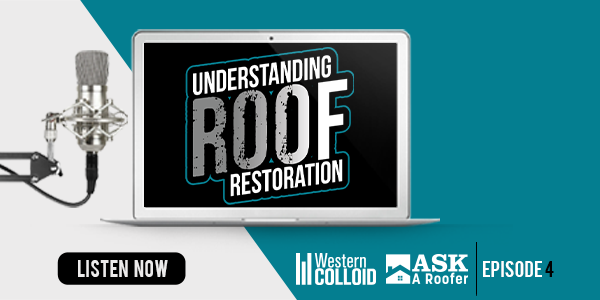
Understanding Roof Restoration Episode 4 - Hail Damage and Fluid Applied Reinforced Roofing - PODCAST TRANSCRIPTION
Read More ...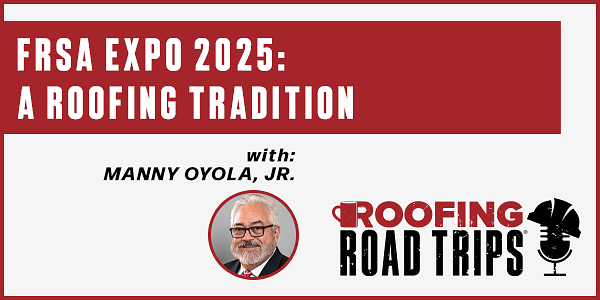
Manny Oyola, Jr. - FRSA Expo 2025: A Roofing Tradition - PODCAST TRANSCRIPT
Read More ...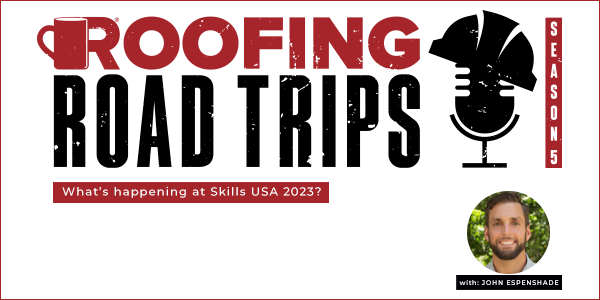
John Esbenshade - What’s happening at Skills USA 2023? - PODCAST TRANSCRIPTION
Read More ...


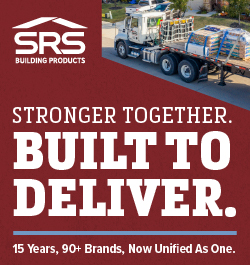












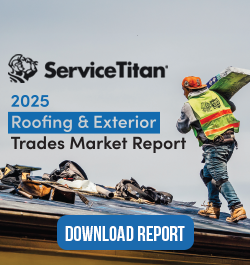


Comments
Leave a Reply
Have an account? Login to leave a comment!
Sign In